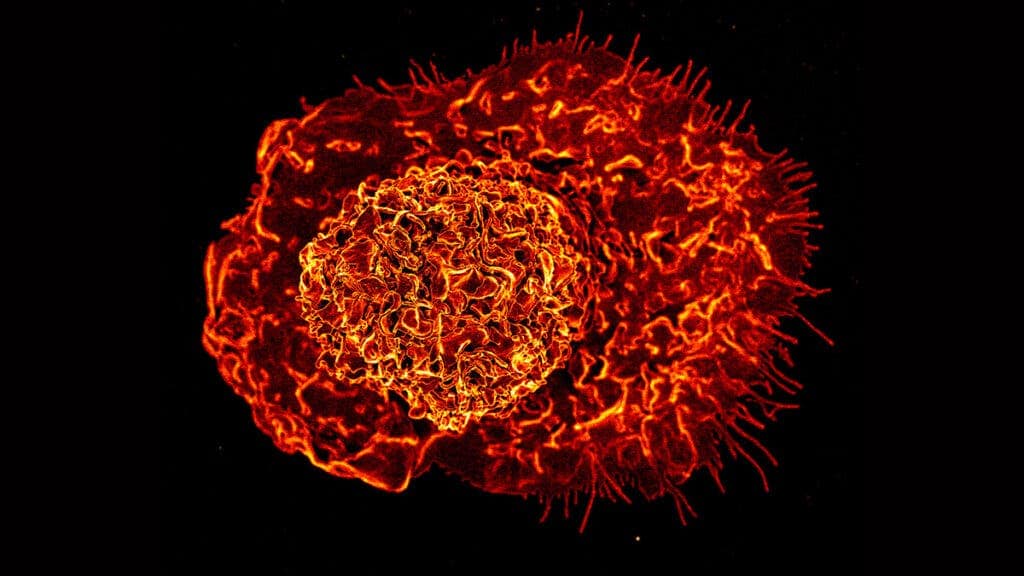
Larger plastics never completely disintegrate to their constituent parts; they simply become smaller bits of plastic. These microplastics not only course from rivers to ocean but also reside in every ecosystem. They’re in rain. They strangle marine life. They choke mangrove forests. They’re at the tops of mountains and the bottom of the world. Such is the influence of this enduring substance that has revolutionized the human world.
From food to feces, scientists know that humans consume tiny shards of plastic. As these trifling fragments traverse the human gut, they might cruise by as benign sightseers, on their way to excretion. Alternatively, evidence is mounting that they disembark and disturb a delicate balance in the colon—home to trillions of microorganisms.
“We like to consider microplastics an inert particulate,” said Eliseo Castillo, an immunologist from the University of New Mexico School of Medicine who presented his group’s findings at the Geological Society of America (GSA) 2021 annual meeting. (The presentation was retroactively withdrawn because of nonpayment of the registration fee.) He had previously spoken on the topic in a Society of Toxicology webinar series in April.
However, if these microplastics pierce the three-tiered veneer of the gut’s security—the microbes, mucus, and a single layer of epithelial cells—the invading plastics would encounter the immune system’s sentinels, called macrophages. In a paper published in Cell Biology and Toxicology, Castillo and his colleagues showed how microplastics change macrophages’ energy-generating mechanisms. In his GSA talk, he explored how similar effects could ripple through the protective layers of the gut, weakening the microbiota itself, which serves as the colon’s first line of defense.
Morphing Macrophage Metabolism
“There are thousands of papers on microplastics,” said Castillo, and “a lot of them deal with invertebrate[s].” Curious about how mammals interact with microplastics, his team focused on mice, whose immune systems’ macrophages are similar to our own. These specialized cells stand guard throughout the body, from brain to lungs, skin to gut, ready to respond to any bodily breach. Should an intruder sneak through the colon’s three-layered defense, Castillo explained, “a macrophage will eat it up.”
Castillo and his team added microplastics to mice macrophages, which the shape-shifting immune cells quickly consumed. “After a 3-day period, we noticed microplastics were still in those cells,” he said. Typically, when a macrophage gobbles dead cells and invading microorganisms, it chews up the gunk (a process called phagocytosis) and expels the refuse for either reuse or elimination. However, Castillo said, “these microplastics weren’t being broken down, and the macrophages were still alive.” Moreover, macrophages with microplastics inside changed their metabolism—the biochemical reactions that keep the cell alive and energized.
For most eukaryotes—any organism that keeps DNA enclosed within a cell’s nucleus—a typical metabolic pathway involves converting sugar and oxygen into energy (cellular respiration). However, cells can also switch to a different kind of metabolism that requires no oxygen, said Castillo. In this case, the sugar breaks down in a process called anaerobic (oxygen-free) glycolysis, which produces less energy per sugar molecule than cellular respiration.
Whether a cell uses respiration or glycolysis affects its immune response, said Castillo. Macrophages reliant on glycolysis, including those jailing microplastics, make molecules that promote inflammation, he explained. Moreover, macrophages containing microplastics displayed slower respiration, possibly because of damage.
Spears, Not Spheres
In typical microplastic studies, said Castillo, “we use microspheres.” In the environment, however, microplastics are less likely to manifest as spheres than as fibers that can easily puncture a cell or infiltrate between them, he said.
The colon harbors more microorganisms than any other part of the digestive tract. These microbes—the gut microbiome—break down fibers and produce molecules our bodies use. Many can live only in oxygen-free environments, said Castillo, and are particularly vulnerable to microplastic spears. In an onslaught of oxygen, he said, anaerobic microbes die. Microbial diversity drops, and the gut is no longer healthy.
Chronic Problem, Policy Solution?
On the basis of unpublished work examining mice poop, microplastics in the gut likely won’t lead to rapid inflammation, but chronic exposure could be harmful, said Castillo. “Over time…microplastics can start to harm, or change, the microbiota, which can start to change the single layer of cells and/or the gut immune system, and this could slowly lead to problems,” he said.
The immune system chronically producing inflammation-related molecules could lead to systemic issues, including Alzheimer’s disease, neurodegeneration, and pulmonary disease, said Tzung Hsiai, a bioengineer and cardiologist at the University of California, Los Angeles who was not involved in the study. If the mechanisms underlying these inflammatory responses or disruption of the gut microbiota can be elucidated, he said, such analysis might provide an avenue for policymakers to react to these issues.
Castillo agreed with Hsiai. “I don’t want to scare people, but we do feel it is important to report our findings to the public,” he said. “Maybe this is an environmental issue that Congress can step in and…deal with, as soon as possible.”
This story originally appeared in Eos Magazine and was republished under a CC BY-NC-ND 3.0 license.






